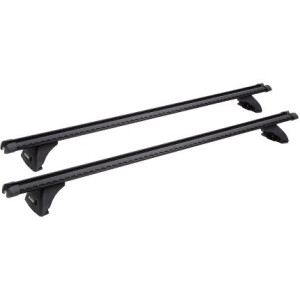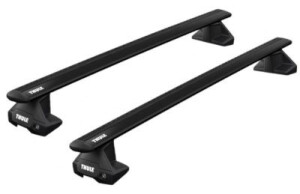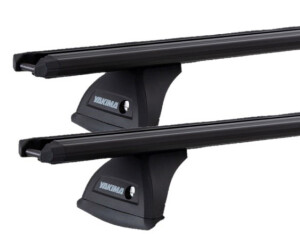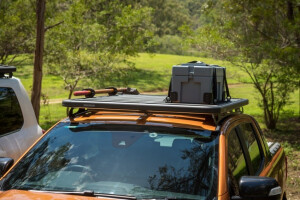
If, like us, you’re not sure whether to call it the Next-Gen Ranger, 2022 Ranger, T6.2 or P703, then chances are buying a roof rack for your brand-new Ford Ranger might get a little confusing. But fear not, we’ve assembled this buyers’ guide to simplify the process for you.
Roof racks are one of the more common and most useful modifications you can make to your four-wheel drive. Even in the ute market (or truck as our American friends call them) where massive amounts of storage are available through trays and tubs, roof racks have their place.
Start adding kitchens, fridges, drawers and any other thing you might fancy to the back of your ute and you might quickly find out that bulky items like swags and tents no longer fit. Or perhaps you just need somewhere to strap down some firewood, traction boards or even granny after you strike oil on the Clampett Farm and move to Beverly Hills.
More than carrying portable gear, roof racks can also be used to mount awnings or driving lights. Any way you look at it, roof racks should be one of the first additions to your touring vehicle set-up.
Before we dive into this guide, first let’s clarify the most confused aspect of roof racks and roofs in general: static vs dynamic load ratings.
The dynamic load rating is the more often quoted rating and refers to how much weight the roof or roof racks can carry when the vehicle is moving. This is typically in the vicinity of 70 to 100kg for most 4WDs, and in the case your brand-new Ranger it’s 85kg (an upgrade of 5kg over the previous generation).
This includes the roof rack itself and anything strapped or bolted on the roof rack. But what happens if you whack a rooftop tent on or just want to climb up on the roof to strap something down? This is where the static roof rating comes into play.
When the vehicle is stationary, your 2022 Ranger is rated to carry 350kg on the roof. So, a couple of people in a rooftop tent is no problem but turning your roof into a terrace bar is probably not advisable. Throughout this buyers’ guide we will typically refer to dynamic load when we compare roof racks.
One key aspect to get right straight up is the mounting options. The new Ford Ranger has rooftop channel mounts for roof racks and platforms, and in Wildtrak form also comes with roof rails.
For this buyers’ guide, we have ignored anything that doesn’t quote a dynamic load rating as a minimum. This does rule out some of the cheapest options, but we’re here to show you the best roof rack for your new Ranger, not the cheapest.
Product Details
For this comparison we have split the roof racks into two categories:
- Basic roof bars; and
- Full roof platforms or racks.
Basic Roof Bars
| Dynamic Load Capacity | Weight | Warranty | Mount Method | |
|---|---|---|---|---|
| Thule WingBar Evo | 75kg | Approx 5kg | 2 years | Rail or channel |
| Prorack HD Roof Bars | 65kg (on-road only) | Approx 6kg | 3 years | Direct to roof or clamp to rails |
| Yakima LockNLoad TrimHD | 65kg | Approx 5kg | Limited Lifetime | Direct to roof or clamp to rails |
Thule WingBar Evo
Things we like
|
Not so much
|
The basic roof bars in this category are the lightweight option for those only wishing to carry smaller loads. The Thule WingBar Evo is a brilliant example and has been designed to imitate an aeroplane wing to make it one of the quietest and most aerodynamic roof racks on the market.
The Evo design extends beyond the mounting points to provide a larger loading area. The aerodynamic shape of the bars is very friendly to the hip pocket as it limits the impact on fuel consumption of adding a roof rack.
With a dynamic load rating of 75kg and weighing in at under 5kg themselves, these racks do leave some of the roof rating wasted but, given that this style of bars are not designed to carry large static loads, it’s not the end of the world.
The method of attachment to the roof varies from clamps over the roof rails on the Wildtrak, to direct roof mounting on other models. The T-tracks (a slot through the top of the bars to mount specialised bolts) allow easy mounting of just about any accessory.
The owner’s manual does state that under no circumstances should a vehicle fitted with these racks exceed 130km/h. Not generally a problem in Australia but worth noting if we ever get unlimited speed roads back in the NT.
Prorack HD Roof Bars T17

Specs:
- Dynamic Load Capacity: 65kg (on-road only)
- Weight: Approx 6kg
- Warranty: 3 years
- Mount Method: Direct to roof or clamp to rails
Things we like
|
Not so much
|
With a slightly reduced weight-carrying capacity of 65kg dynamic load, these bars are another basic option for those without the need to carrying anything heavy.
The big advantage of these bars is the lockable mounts plus lockable end caps, meaning that they are the secure option for anyone that might leave expensive accessories mounted full-time. The aerodynamic design is based on an owl wing and reduces noise, drag and fuel consumption compared to square bars.
The bars themselves are rated to 100kg, so they should be built strong, but the reduced rating specific to the Ranger and the resultant waste of Ranger roof-load capacity is a bit of a let-down.
This does get worse off road, where Prorack recommends a 33 per cent reduction in load for off-road use on its heavy-duty models. This means your 65kg capacity drops to around 44kg as soon as you leave the tar.
This off-road recommendation is fairly common among manufacturers and is often in the fine print, so be sure to keep an eye out for it if you plan to carry anything close to the load-rating limit.
The bars include a T-slot to allow easy mounting of accessories and integrated tie-down points to strap down that swag. The method of attachment varies from clamps over the roof rails on the Wildtrak to direct roof mounting on other models.
Yakima LockNLoad TrimHD
Things we like
|
Not so much
|
This is the one for avid off-roaders. Yakima claims that once they have built a rack, they beat the hell out of it on snow covered mountains to remote dirt roads to give you the toughest roof racks on the market. To back up the claim Yakima offers a limited lifetime warranty.
The TrimHD is another with a load capacity of 65kg and weight of around 5kg meaning there’s 15kg of Ranger roof-load capacity wasted. A common theme in this category, as you would have seen by now.
The racks include integrated mount point and a T-slot to allow mounting of accessories. There’s no fancy flying design on this one. It’s designed to work. The tie-down points at the end of each bar are a nice design feature and will make strapping down bulky items like swags and tents a breeze.
Full Roof Platforms or Racks
Unfortunately being so new, there are some details missing as manufacturers scramble to update their systems for the new Ranger. Nonetheless, we have some really great options in this category and time should bring even more.
| Dynamic Load Capacity | Weight | Warranty | Mount Method | |
|---|---|---|---|---|
| Wedgetail roof rack | 85kg | Approx 24kg | Contact manufacturer | Channel |
| Rhino-Rack Pioneer Platform | 85kg | Approx 20kg | 5 years | Channel or roof rail clamp |
| Yakima RuggedLine | 85kg | Approx 21kg | Limited Lifetime | Channel |
Wedgetail Platform Roof Rack

Specs:
- Dynamic Load Capacity: 85kg
- Weight: Approx 24kg
- Warranty: Contact manufacturer
- Mount Method: Channel
Things we like
|
Not so much
|
Designed and built by Tradesman Roof Racks in Melbourne, this rack is well-designed and built to last. The mounting system rivets into the factory channel and in the case of the Wildtrak, requires removal of the factory rails.
The clever design means that the rack can be removed and reinstalled as required, using only four bolts.
A series of crossbars allow for the mounting of tie-down points and at 1250mm wide and 1400mm long, this rack has plenty of room. It’s long enough to fit a full-size set of MaxTrax comfortably.
The wind deflector on the front reduces noise and drag, and the ‘Wedge-lock’ corners ensure a sturdy product.
There’s no off-road reduction here. The full load rating applies to any conditions. That means a handy 61kg (85kg roof rating less 24kg rack weight) of dynamic load capacity anywhere, anytime.
The bar-type design on this roof platform is relatively unusual and is what separates this from the rest. With its ‘unistrut’ bars rather than slats, the Wedgetail platform is ready to work during the week and play on the weekend.
Rhino-Rack Pioneer Platform

Specs:
- Dynamic Load Capacity: 85kg
- Weight: Approx 20kg
- Warranty: 5 years
- Mount Method: Rail or roof rail clamp
Things we like
|
Not so much
|
Rhino-Rack’s backbone mounting system has suffered from a little bit of bad publicity regarding off-road load-rating reductions in recent times and, from an off-roaders perspective, that’s fair enough. But with this recent upgrade, the load rating is now totally uncompromised and applicable anywhere, anytime.
So, with a weight of around 20kg, the Rhino-Rack is ready to carry 65kg anywhere. The backbone mounting system will require removal of the factory rails on the Wildtrak, but there’s also a clamp mounting system for the rails available. The clamp system will require four RX100 feet, but is lightning fast to instal compared to the backbone system.
At 1528mm long and 1236mm wide, the platform is a decent size and ready to take a rooftop tent if required. There are optional wind deflectors available to help reduce wind noise and drag.
Yakima RuggedLine
Things we like
|
Not so much
|
Coming in a little cheaper than others in this category, doesn’t mean the Yakima RuggedLine isn’t built to last. Yakima claims to torture test its products and as a result, can offer a limited lifetime warranty.
This is a no frills, tough roof rack that is ready to work. The platform is rated to 100kg and is, therefore, limited to 85kg by the Ranger roof load rating. Coming in at around 21kg, it leaves you with 64kg of load capacity ready to go anywhere.
At 1530mm long and 1240mm wide, this rack is on the larger size in this category and this, combined with the easy to use built-in perimeter channels, allows mounting of a range of accessories or a rooftop tent.
The RuggedLine is lacking some of the bells and whistles like wind deflectors and has a beefier design than some competitors, but if you’re actually using it to transport anything bulky, let’s be honest, a wind deflector isn’t going to help you.
But if the ute is just a work transport for 360 days a year, then maybe you will want something a little more efficiently designed.
HOW WE REVIEW PRODUCTS
4X4 Australia has been reviewing four-wheel drive vehicles and aftermarket products for more than 40 years.
When looking for the best roof racks for the Next-Gen Ford Ranger available in Australia we considered quality (value for money), efficiency of design and functionality. We compared features across hundreds of products split in two categories based on price point and simplicity: basic roof bars; and full rack systems.
Typically, we would look at users' reviews, however, being such a new variant, there simply isn’t much experience out there. So instead, we have relied on user reviews and experience of previous models together with any relevant updates from manufacturers to make sure our recommendations are for the best on the market.
We’ve also included a few pointers on what to look for when purchasing a roof-rack system and how to avoid being ripped off or disappointed.
Disclosure: When you buy through our links, we may earn a commission. We also include products that we do not earn a commission from.
BUYERS’ GUIDE 2022 NEXT-GEN FORD RANGER ROOF RACKS
Storage space in just about any touring vehicle is at a premium. When we start adding canopies with fridge slides, drawers, kitchens and anything else to make life on (and off) road easier, we start to run out of space to store bulky items like swags, tents and recovery boards.
This is where roof racks come into play. They’re brilliant for transporting bulky but light items. The old square steel bars or big heavy steel racks are a thing of the past. These days we have bars based on aeroplane and bird wings.
Designed for aerodynamics and noise reduction, there’s no need to be driving down the motorway sounding like there’s a kettle boiling on the roof.
With the rising popularity of rooftop tents, roof pods and every accessory mount under the sun (shovels, high-lift jacks, traction-board quick releases), so comes improved mounting systems. It’s never been easier to strap down your gear and head bush.
The Next-Gen Ranger comes with an increased roof-load rating over the previous models (85kg vs 80kg) and, as a result, suits a roof rack even more.
Quality (Value For Money)
Have a quick search of the internet and you’re sure to find dozens of cheap roof-rack options. The problem is that most of them have been designed based on something as aerodynamic as a brick and don’t have any published load rating.
See that bloke driving along being chased by all the neighbourhood dogs? It’s either because he’s a butcher with sloppy packing skills or because his roof racks are whistling like crazy.
The lack of a published load rating is risky, not just for you and your Ranger, but for anyone that might be following you. Overload a roof rack off road and you’re asking for trouble. There’s plenty of stories around about entire racks coming free, load and all still attached.
For these reasons we’ve excluded anything without a published load rating and have stuck to reputable brands. Value adding features like clever accessory mounting systems and efficient designs have been highly regarded here. A solid warranty ensures peace of mind and adds to that value too.
Functionality
So, what is a roof rack for? To transport stuff, right? Every time you do this, you either need to use a purpose-built accessory carrier or you need to strap it down. Attaching accessories and strapping down anything else needs to be simple.
How easy this is to do will tend to govern how often you’re willing to use the racks. Modern roof racks include slots along the top ready to mount eyelets for strapping gear down or ready-to-bolt-on accessory carriers.
Roof racks that require straps and ropes to be tied around the bars or hooked into areas that aren’t designed for that purpose, are hard work and just make life difficult.
When considering what you will use your roof rack for, consider that platforms have the added advantage of a totally flat surface ready to take swags, tents, etc. at a pinch or have a rooftop tent mounted.
Racks that can be quickly removed are super handy for anyone that might use their vehicle for the shopping run or need to park in a low-height garage. The ability to undo four bolts and fit in your garage vs a 90-minute uninstal process, is super handy for those in that situation.
The key here is thinking about how you will use your roof rack and what type of system works best for your needs.
Efficiency of design
Every time we add something to our four-wheel-drives, we are effectively increasing weight and drag (wind resistance). Be it suspension lifts, bigger tyres, drawer systems or bullbars. They all work to do one thing. Make that little fuel gauge on the dash drop quicker.
So wherever possible, we want to limit this effect. This means roof racks with clever aerodynamic designs are highly valued. Added features like wind deflectors should be considered for Rangers that will spend a fair proportion of their life with an empty roof.
More than this, adding bolt-on accessories runs the risk or creating noise; square roof bars are famous for this. Designs that have considered noise reductions really do make the driving experience that much better.
How to avoid being ripped off
There are plenty of cheap roof racks on the market, but especially with a vehicle as new as the Next-Gen Ranger, you really want something that has been designed and built for this vehicle. Cheap racks without proper load ratings and testing are a big risk.
These things rarely go wrong five minutes from home. More often than not, it’s when you’re halfway across the Simpson Desert or part way around that once in a lifetime big lap.
Keep an eye out for limitations in the fine print like load reductions for off-road use or speed limits. Put your 60kg rooftop tent on a platform with 65kg load rating and think you’re all good? What about the 1.5 times reduction in load rating for off-road use the manufacturer has hidden in the fine print?
That 65kg is all of a sudden 43kg and you’re over weight. Goodbye warranty and worse, you could run the risk of ruining a trip. Thankfully, some manufacturers have sorted this issue out recently but many still include this. It’s often not an issue if you’re only throwing a swag up on top, but if you’re running anywhere near that load limit, it’s something to check.
After-sales support
More than confidence to actually get out there and use your shiny new Ranger with a rack full of gear, well-known and respected brands also typically have spare parts in the event anything does go wrong.
A good warranty means that if something does go wrong, hopefully, it’s not you paying for those replacement parts. Focus too much on price and chances are you will end up with a rack that disappoints, doesn’t last as long as it should and may come unstuck at the worst possible time.
Safety & Loading
Start travelling to remote areas of this wide, brown land and you will certainly come across roof racks that are a disaster waiting to happen. Overloading is the scourge of roof racks and it’s something that is easy to do if you’re not careful.
Think about the Ranger and it’s 85kg roof rating. Throw on a 20kg roof platform and you’ve got 65kg to play with. Put a 20L diesel jerry can (20kg), a 20L water jerry can (20kg), a side awning (10kg), a double swag (20kg) and you will find your at 70kg and overweight.
The number of times we’ve seen rows of four jerry cans, plus a gas bottle, plus tents/swags on the roofs of 4WDs is scary. That’s well over 100kg.
The worst is when you come across all of the above still strapped to a roof of a vehicle sitting on its side. Roof racks are super handy but like anything on a touring vehicle, they need to treated carefully or bad things happen.




COMMENTS